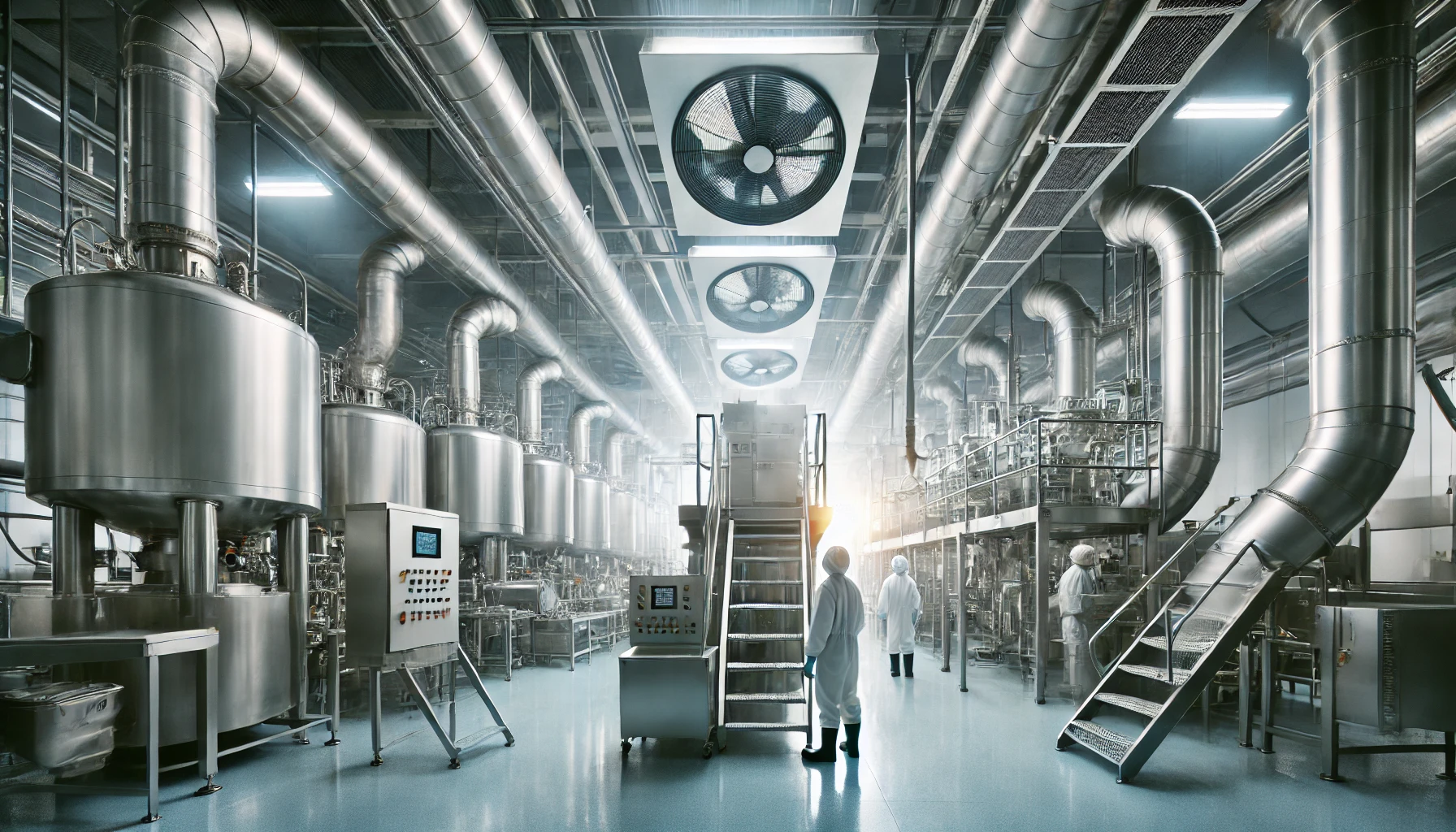Introduction
In the modern food processing industry, maintaining high air quality standards is essential for ensuring product safety, worker health, and regulatory compliance. Industrial fume extraction fans play a critical role in controlling airborne contaminants, filtering hazardous particles, and improving workplace conditions. This article explores the benefits, applications, and selection criteria for industrial fume extraction fans in food production facilities across Europe.
Why Air Quality Matters in the Food Industry
Impact on Food Safety
Airborne contaminants such as grease, smoke, and fine particles can settle on food products, compromising hygiene and quality. Contaminated air may also facilitate the growth of bacteria, fungi, and mold, leading to spoilage and potential health risks for consumers.
Worker Health and Safety
Food processing facilities often involve high-temperature cooking, frying, and baking processes that generate fumes containing volatile organic compounds (VOCs) and particulate matter. Prolonged exposure to these contaminants can lead to respiratory problems, skin irritation, and long-term health effects among workers.
Compliance with European Regulations
Regulatory bodies such as the European Food Safety Authority (EFSA) and the European Agency for Safety and Health at Work (EU-OSHA) mandate strict air quality standards in food manufacturing environments. Implementing effective fume extraction systems helps businesses adhere to these regulations and avoid legal repercussions.
The Role of Industrial Fume Extraction Fans
What Are Industrial Fume Extraction Fans?
Industrial fume extraction fans are high-efficiency ventilation systems designed to capture and remove airborne contaminants. These fans work in conjunction with filtration units to ensure clean and breathable air in food processing environments.
How Do They Work?
- Capture Phase – Contaminants are collected at the source using localized extraction hoods or ducts.
- Filtration Phase – Airborne particles and gases pass through filtration units, which may include HEPA filters, activated carbon filters, and electrostatic precipitators.
- Exhaust Phase – Cleaned air is either recirculated or expelled outside the facility to maintain a safe working environment.
Applications of Fume Extraction Fans in the Food Industry
Cooking and Frying Processes
High-temperature cooking methods generate grease-laden smoke and VOCs. Fume extraction fans ensure that these pollutants do not accumulate within production areas, reducing fire hazards and maintaining equipment efficiency.
Baking and Roasting Operations
Ovens and roasters release fine particles and combustion gases. Proper ventilation systems help remove these emissions and prevent contamination of baked goods.
Food Packaging and Processing
Certain packaging materials emit fumes when exposed to heat or chemical treatments. Industrial extraction systems mitigate these emissions, safeguarding both employees and products.
Dairy and Cheese Production
Dairy processing involves pasteurization, fermentation, and drying processes that release odors and moisture. Effective ventilation minimizes bacterial growth and ensures product consistency.
Choosing the Right Industrial Fume Extraction Fan
Key Factors to Consider
- Airflow Capacity – The fan should provide adequate airflow to remove contaminants efficiently without disrupting production.
- Filtration Technology – The system should incorporate appropriate filters for grease, smoke, and chemical vapors.
- Energy Efficiency – Low-energy consumption models reduce operational costs while maintaining optimal performance.
- Compliance with Industry Standards – The fan should meet EU directives for air quality and safety in food production environments.
- Maintenance Requirements – Easy-to-clean designs minimize downtime and ensure consistent performance.
Popular Types of Industrial Fume Extraction Fans
- Centrifugal Fans – Ideal for high-pressure applications and removal of dense fumes.
- Axial Fans – Suitable for general ventilation and high-volume air circulation.
- Inline Duct Fans – Used for localized extraction in confined spaces.
- Electrostatic Precipitator Systems – Capture ultrafine particles using electrostatic charges.
Benefits of Implementing Fume Extraction Systems in Food Manufacturing
Improved Product Quality
By eliminating airborne contaminants, fume extraction fans contribute to cleaner production environments, reducing the risk of food contamination and improving shelf life.
Enhanced Workplace Safety
Proper ventilation minimizes exposure to hazardous fumes, creating a healthier work environment and reducing occupational health risks.
Increased Equipment Lifespan
Airborne grease and particles can accumulate on machinery, leading to inefficiencies and frequent breakdowns. Effective extraction systems protect equipment, extending its operational life.
Regulatory Compliance
Maintaining clean air ensures adherence to health and safety regulations, preventing potential fines and legal complications.
Cost Savings
Energy-efficient extraction systems reduce power consumption, and fewer contamination-related recalls lower overall production costs.
Future Trends in Fume Extraction Technology for Food Production
Smart Ventilation Systems
The integration of IoT and AI in ventilation technology allows for real-time air quality monitoring and automated adjustments to optimize efficiency.
Advanced Filtration Materials
Emerging filter technologies, such as nanofiber filters and bio-based carbon materials, offer enhanced air purification while being environmentally sustainable.
Energy Recovery Ventilation (ERV)
New ERV systems recover heat from extracted air, reducing energy costs and improving sustainability in food processing plants.
Conclusion
Investing in high-quality industrial fume extraction fans is crucial for food manufacturers looking to enhance air quality, ensure regulatory compliance, and protect worker health. By selecting the right ventilation system and adopting the latest technologies, companies can optimize their production processes while maintaining the highest standards of hygiene and safety.
For businesses seeking reliable fume extraction solutions, partnering with specialized ventilation providers can ensure customized systems tailored to specific food processing needs.




